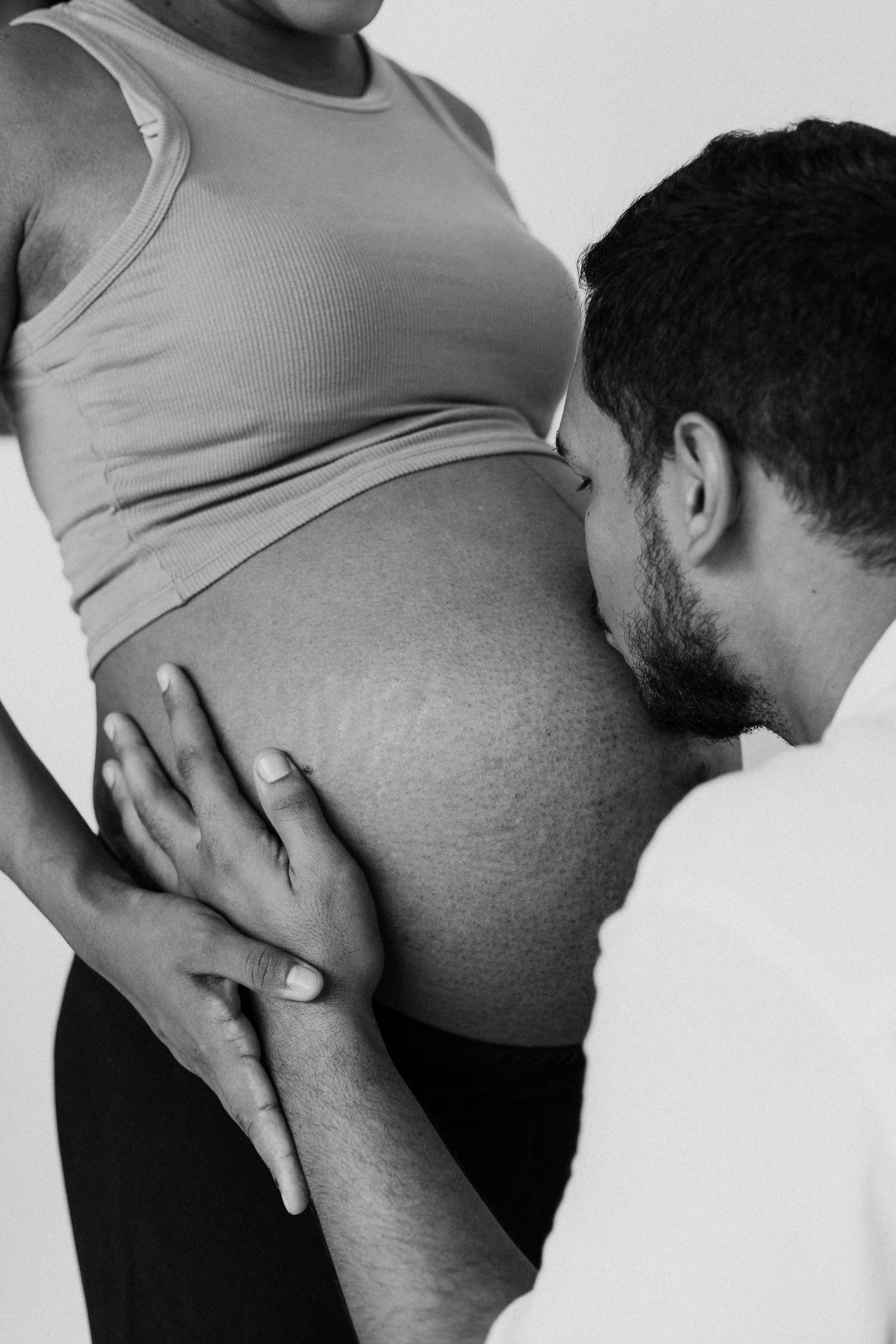
Ripening
the third trimester
When fruit swells heavy on the branch, full of promise as it ripens towards harvest. Within your womb, baby stretches and strengthens, preparing to meet the world. The body slowing, softening, and widening to make way for birth. As you carry the weight of new life and lean into the mystery of timing, you are reminded that labor is not just about giving birth, but it is the transformation where woman becomes mother. Where the love that has lived quietly within you, now takes shape in the world.
Foundations for this Season
A gentle guide to preparing your body, heart, and home as you await the arrival of new life.
Nourishment
Rest
Preparation
What to expect in your third trimester
The third trimester (weeks 28-40) is a season of ripening and readiness — your baby grows rapidly, your body shifts to make space, and you prepare for birth. Sleep may be interrupted, and physical discomforts can increase, but so does the anticipation of meeting your little one.
It’s a time of both surrender and strength, as you lean into trust and ready yourself for the threshold of motherhood.
In the span of twelve weeks, pregnancy ripens toward its culmination — a season of anticipation and preparation.
For baby, growth is now about refinement and readiness. Lungs mature, fat layers build for warmth, and brain development accelerates at astonishing speed. Baby practices blinking, breathing, and grasping, while settling into position for birth. By the final weeks, baby is nearly ready to meet the world.
For mama, the body softens, widens, and slows to make space for new life. Sleep may be interrupted, hips may ache, and swelling or heartburn can increase — yet there is also deep anticipation with each tightening, each flutter, each new curve of your belly. Emotionally, this is a time of nesting, reflecting, and preparing for the threshold of labor and motherhood.
Behind the scenes, your body rehearses birth with Braxton Hicks contractions and shifts hormone patterns to prepare for labor. This trimester calls for surrender — a trust in timing, in your body’s wisdom, and in the profound transformation that awaits.
From discomfort to anticipation, here’s what might show up.
As you enter the final stretch, experiences vary widely. Some women feel grounded and calm, savoring the closeness of carrying their baby. Others wrestle with swollen feet, heartburn, sleepless nights, or the sheer weight of their growing belly. While some find strength and focus in these last weeks, others feel vulnerable, emotional, and ready to be done.
The common thread of the third trimester is preparation — both body and soul readying for the threshold of birth. Baby is practicing life on the outside, and your body rehearses with Braxton Hicks contractions, hormonal shifts, and softening tissues. Trust your own rhythm, honor your need for rest or nesting, and lean into the supports that help you feel safe. There’s no one way to “do” the third trimester — your body knows the way, and your job is to listen, trust, and prepare for the transformation to come.
-
What’s Happening
A heavier belly can bring back pain, pelvic pressure, hip aches, swelling, and sleep interruptions.
How to Prepare
Invest in supportive pillows, belly bands, and compression socks. Prioritize rest breaks and use warm baths or gentle stretches for relief. -
What’s Happening
Baby presses on your diaphragm and stomach, causing shortness of breath, heartburn, or indigestion.
How to Prepare
Eat smaller, frequent meals, avoid lying down right after eating, and practice upright breathing positions to open lung space. -
What’s Happening
Braxton Hicks contractions (tightening sensations) help your body “practice” for labor.
How to Prepare
Stay hydrated, shift positions, and rest when they appear. Track intensity — if contractions grow regular or painful, call your provider. -
What’s Happening
Baby gains weight, builds fat, and strengthens movements. By late third trimester, baby often settles head-down.
How to Prepare
Practice daily kick counts. Sit or lean forward to encourage optimal positioning, and enjoy these strong reminders of the life within. -
What’s Happening
Hormones, anticipation, and the nearness of birth can bring excitement, nervousness, or sudden bursts of nesting energy.
How to Prepare
Channel energy into light organizing, packing a birth bag, or prepping meals — but balance it with stillness and reflection. Use affirmations and grounding rituals to ease emotions.
Third Trimester Timeline
-
Weeks 28–29: The Ripening Season
Baby begins to gain weight more rapidly, adding fat for warmth and energy. The brain and nervous system are developing at an incredible pace.
Mama may notice her belly feeling heavier, sleep becoming more disrupted, and new waves of anticipation beginning to rise.

-
Weeks 30–31: Growing Stronger
Baby practices important skills like breathing movements, sucking, and blinking. The skeleton hardens, while bones in the skull remain flexible for birth.
Mama may experience more back pain, swelling, or restless legs. Compression socks, hydration, and body pillows become supportive allies.

-
Weeks 32–33: Nesting Energy
Baby’s kicks and rolls are strong and regular, and baby is likely head-down by now. Growth slows slightly, but development is focused on maturity and readiness.
Mama may feel bursts of nesting energy alongside fatigue. Emotional waves of excitement and nerves are common.

-
Weeks 34–35: Preparing for Birth
Baby’s lungs and digestive system mature, and fat stores increase, giving baby that round, full appearance.
Mama may feel Braxton Hicks contractions more often, practice tightening that signals the body’s rehearsal for labor. Heartburn and shortness of breath may peak.

-
Weeks 36–37: The Threshold Approaches
Baby’s movements may feel more like rolls and stretches as space grows tight. Baby is considered “early term” by 37 weeks.
Mama may feel pelvic pressure, more frequent urination, and signs of her body softening and widening for birth.

-
Weeks 38–40+: Fullness of Time
Baby continues fine-tuning reflexes, layering fat, and preparing for life outside the womb.
Mama may experience stronger Braxton Hicks or the onset of real contractions. This is a season of waiting and surrender, when labor can begin at any moment.

Third Trimester — Appointments & Testing
Preparing for birth and monitoring baby’s readiness
More Frequent Checkups:
Appointments shift to every 2 weeks (28–36 weeks) and then weekly (36 weeks onward).
Includes measuring fundal height, baby’s position, and listening to baby’s heartbeat.
Key Testing (around 35–37 weeks):
Group B Strep test (GBS) — a vaginal/rectal swab to check for bacteria that may be treated during labor.
Cervical checks may begin closer to your due date to assess dilation or effacement.
Other Monitoring (if needed):
Nonstress test (NST) or Biophysical profile if you go past your due date, have twins, or certain risk factors.
What to Know:
These appointments focus on birth readiness — tracking your baby’s position, your body’s signs of labor, and planning for delivery.
Books Worth Reading
Shopping Guide
Third Trimester : Gathering the Harvest
If you haven’t already…
Everyday Support
Give your body extra care as it carries more weight each day. A maternity support belt can gently lift your belly to relieve back pain, pelvic pressure, and fatigue, while compression socks encourage circulation and help prevent swelling in your feet, ankles, and calves — especially during long days or travel.
Prepare your body for labor …
Belly Oil
Keep your skin soft, nourished, and elastic as it stretches. Look for ingredients like Sweet Almond, Rosehip, or Jojoba oils, and apply daily to damp skin over your belly, hips, breasts, thighs, and lower back to soothe and hydrate.
Peaceful Sleep
Rest becomes even more precious in these final weeks. A full body pillow can cradle your belly, hips, and back to keep you comfortable while side-sleeping. Magnesium spray can help relax tense muscles, ease leg cramps, and support deeper, more restful sleep.
Perineal Massage Oil & Wand
Begin gently preparing your body for birth a few weeks before your due date. A nourishing perineal oil can soften and hydrate the tissues, while a perineal massage wand can help you reach the area comfortably and apply gentle, even pressure to improve elasticity. Together, they can support circulation, reduce tension, and help lower the risk of tearing during delivery.
Labor & Postpartum Essentials
Gather what will help you feel cozy, calm, and cared for through labor and early recovery — a birth ball to encourage optimal positioning, soft socks, a robe, a nursing-friendly nightgown, a water bottle with a straw, and postpartum pads or disposable underwear.
Optional Boosters
Continue your prenatal and supportive additions as your baby completes their final growth. Red Raspberry Leaf Tea can gently prepare your uterus for labor (always check with your provider first). Eating a few dates each day in the final weeks has also been linked to promoting cervical ripening and supporting a smoother labor.









